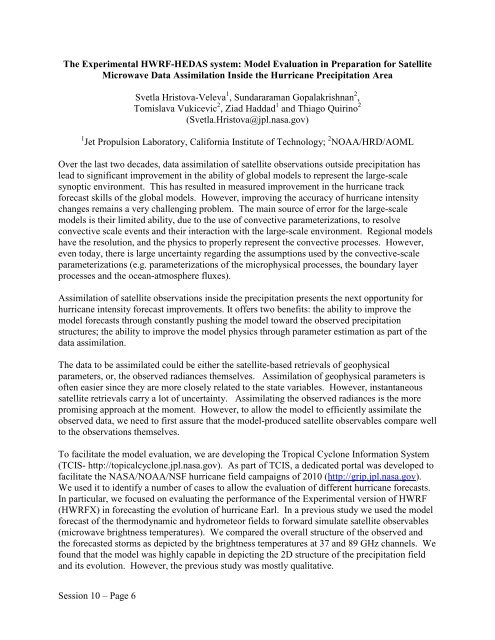65th IHC Booklet/Program (pdf - 4.9MB) - Office of the Federal ...
65th IHC Booklet/Program (pdf - 4.9MB) - Office of the Federal ...
65th IHC Booklet/Program (pdf - 4.9MB) - Office of the Federal ...
Create successful ePaper yourself
Turn your PDF publications into a flip-book with our unique Google optimized e-Paper software.
The Experimental HWRF-HEDAS system: Model Evaluation in Preparation for Satellite<br />
Microwave Data Assimilation Inside <strong>the</strong> Hurricane Precipitation Area<br />
Svetla Hristova-Veleva 1 , Sundararaman Gopalakrishnan 2 ,<br />
Tomislava Vukicevic 2 , Ziad Haddad 1 and Thiago Quirino 2<br />
(Svetla.Hristova@jpl.nasa.gov)<br />
1 Jet Propulsion Laboratory, California Institute <strong>of</strong> Technology; 2 NOAA/HRD/AOML<br />
Over <strong>the</strong> last two decades, data assimilation <strong>of</strong> satellite observations outside precipitation has<br />
lead to significant improvement in <strong>the</strong> ability <strong>of</strong> global models to represent <strong>the</strong> large-scale<br />
synoptic environment. This has resulted in measured improvement in <strong>the</strong> hurricane track<br />
forecast skills <strong>of</strong> <strong>the</strong> global models. However, improving <strong>the</strong> accuracy <strong>of</strong> hurricane intensity<br />
changes remains a very challenging problem. The main source <strong>of</strong> error for <strong>the</strong> large-scale<br />
models is <strong>the</strong>ir limited ability, due to <strong>the</strong> use <strong>of</strong> convective parameterizations, to resolve<br />
convective scale events and <strong>the</strong>ir interaction with <strong>the</strong> large-scale environment. Regional models<br />
have <strong>the</strong> resolution, and <strong>the</strong> physics to properly represent <strong>the</strong> convective processes. However,<br />
even today, <strong>the</strong>re is large uncertainty regarding <strong>the</strong> assumptions used by <strong>the</strong> convective-scale<br />
parameterizations (e.g. parameterizations <strong>of</strong> <strong>the</strong> microphysical processes, <strong>the</strong> boundary layer<br />
processes and <strong>the</strong> ocean-atmosphere fluxes).<br />
Assimilation <strong>of</strong> satellite observations inside <strong>the</strong> precipitation presents <strong>the</strong> next opportunity for<br />
hurricane intensity forecast improvements. It <strong>of</strong>fers two benefits: <strong>the</strong> ability to improve <strong>the</strong><br />
model forecasts through constantly pushing <strong>the</strong> model toward <strong>the</strong> observed precipitation<br />
structures; <strong>the</strong> ability to improve <strong>the</strong> model physics through parameter estimation as part <strong>of</strong> <strong>the</strong><br />
data assimilation.<br />
The data to be assimilated could be ei<strong>the</strong>r <strong>the</strong> satellite-based retrievals <strong>of</strong> geophysical<br />
parameters, or, <strong>the</strong> observed radiances <strong>the</strong>mselves. Assimilation <strong>of</strong> geophysical parameters is<br />
<strong>of</strong>ten easier since <strong>the</strong>y are more closely related to <strong>the</strong> state variables. However, instantaneous<br />
satellite retrievals carry a lot <strong>of</strong> uncertainty. Assimilating <strong>the</strong> observed radiances is <strong>the</strong> more<br />
promising approach at <strong>the</strong> moment. However, to allow <strong>the</strong> model to efficiently assimilate <strong>the</strong><br />
observed data, we need to first assure that <strong>the</strong> model-produced satellite observables compare well<br />
to <strong>the</strong> observations <strong>the</strong>mselves.<br />
To facilitate <strong>the</strong> model evaluation, we are developing <strong>the</strong> Tropical Cyclone Information System<br />
(TCIS- http://topicalcyclone.jpl.nasa.gov). As part <strong>of</strong> TCIS, a dedicated portal was developed to<br />
facilitate <strong>the</strong> NASA/NOAA/NSF hurricane field campaigns <strong>of</strong> 2010 (http://grip.jpl.nasa.gov).<br />
We used it to identify a number <strong>of</strong> cases to allow <strong>the</strong> evaluation <strong>of</strong> different hurricane forecasts.<br />
In particular, we focused on evaluating <strong>the</strong> performance <strong>of</strong> <strong>the</strong> Experimental version <strong>of</strong> HWRF<br />
(HWRFX) in forecasting <strong>the</strong> evolution <strong>of</strong> hurricane Earl. In a previous study we used <strong>the</strong> model<br />
forecast <strong>of</strong> <strong>the</strong> <strong>the</strong>rmodynamic and hydrometeor fields to forward simulate satellite observables<br />
(microwave brightness temperatures). We compared <strong>the</strong> overall structure <strong>of</strong> <strong>the</strong> observed and<br />
<strong>the</strong> forecasted storms as depicted by <strong>the</strong> brightness temperatures at 37 and 89 GHz channels. We<br />
found that <strong>the</strong> model was highly capable in depicting <strong>the</strong> 2D structure <strong>of</strong> <strong>the</strong> precipitation field<br />
and its evolution. However, <strong>the</strong> previous study was mostly qualitative.<br />
Session 10 – Page 6
















